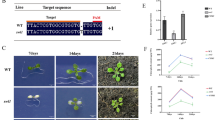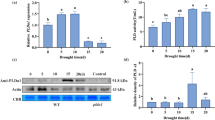Abstract
Nitrate reductase (NR) is an important enzyme for nitrate assimilation in plants, and its activity is regulated by post-translational phosphorylation. The change of nitrogen uptake affects the response of rice to low temperature and its growth. To investigate the effect of NIA1 protein dephosphorylation on the growth of rice and its adaptability to low temperature, we analyzed phenotype, chlorophyll content, nitrogen utilization, and antioxidant capacity at low temperature in lines with a mutated NIA1 phosphorylation site (S532D and S532A), an OsNia1 over-expression line (OE), and wild-type Kitaake rice (WT). Plant height, dry matter weight, and chlorophyll content of S532D and S532A were lower than those of WT and OE under normal growth conditions but were higher than those of WT and OE at low temperature. Compared with WT and OE, the nitrite, H2O2, and MDA contents of S532D and S532A leaves were higher under normal growth conditions. The difference in leaf nitrite content between transgenic lines and WT was narrower at low temperature, especially in S532D and S532A, while H2O2 and MDA contents of S532D and S532A leaves were lower than those in WT and OE leaves. The NH4+-N and amino acid contents of S532D and S532A leaves were higher than those of WT and OE leaves under normal or low temperature. qRT-PCR results revealed that transcription levels of OsNrt2.4, OsNia2, and OsNADH-GOGAT were positively correlated with those of OsNia1, and the transcription levels of OsNrt2.4, OsNia2, and OsNADH-GOGAT were significantly higher in transgenic lines than in WT under both normal and low temperature. Phosphorylation of NR is a steady-state regulatory mechanism of nitrogen metabolism, and dephosphorylation of NIA1 protein improved NR activity and nitrogen utilization efficiency in rice. Excessive accumulation of nitrite under normal growth conditions inhibits the growth of rice; however, accumulation of nitrite is reduced at low temperature, enhancing the cold tolerance of rice. These results provide a new insight for improving cold tolerance of rice.








Similar content being viewed by others
Data Availability
The datasets used and/or analysed during the current study are available from the corresponding author on reasonable request. Sequences used in this study are available from the National Center for Biotechnology Information (NCBI).
References
Bachmann M, Shiraishi N, Campbell WH, Yoo BC, Harmon AC, Huber SC (1996) ldentification of Ser-543 as the major regulatory phosphorylation site in spinach leaf nitrate reductase. Plant Cell 8:505–517
Britto DT, Kronzucker HJ (2002) NH4+ toxicity in higher plants: a critical review. J Plant Physiol 159:567–584
Cai XL (2014) Coupling effects of the low temperature and high nitrogen on yield formation and its physiological mechanism for double cropping super hybrid rice. Jiangxi agricultural university, Nanchang
Cao N, Xiong QQ, Chen XR, He HH, Zhu CL, Fu JR et al (2018) Effects of different nitrogen application rates on low temperature resistance of late rice at heading and flowering stage. Chin J Appl Ecol 29:2566–2574
Cao CH, Shen TH, Shi X, Xiong QQ, Chen XR, He HH (2020) Yield and physiological differences of late rice varieties in response to low temperature at heading and flowering stage under different nitrogen levels. Acta Agricultural Boreali-Sinica 35:178–186
Cataldo DA, Maroon M, Schrader LE, Youngs VL (1975) Rapid colorimetric determination of nitrate in plant tissue by nitration of salicylic acid. Commun Soil Sci Plan 6:71–80
Chen J, Zhang HQ, Hu LB, Shi ZQ (2013) Microcystin-LR-induced phytotoxicity in rice crown root is associated with the cross-talk between auxin and nitric oxide. Chemosphere 93:283–293
Chung IM, Kim JJ, Lim JD, Yu CY, Kim S, Hahn SJ (2006) Comparison of resveratrol, SOD activity, phenolic compounds and free amino acids in Rehmannia glutinosa at temperature and water stress. Environ Exp Bot 56:44–53
Crawford NM (1995) Nitrate: nutrient and signal for plant growth. Plant Cell 7:859–868
Deng HB, Che FL, Xiao YH, Tang WB, Pan Y, Liu ZX et al (2011) Effects of low temperature stress during flowering period on pollen characters and flag leaf physiological and biochemical characteristics of rice. Chin J Appl Ecol 1:66–72
Faure J, Vincentz M, Kronenberger J, Caboche M (1991) Co-regulated expression of nitrate and nitrite reductases. Plant J 1:107–113
Gill SS, Tuteja N (2010) Reactive oxygen species and antioxidant machinery in abiotic stress tolerance in crop plants. Plant Physiol Bioc 48:909–930
Hachiya T, Watanabe CK, Fujimoto M, Ishikawa T, Takahara K, Kawai-Yamada M et al (2012) Nitrate addition alleviates ammonium toxicity without lessening ammonium accumulation, organic acid depletion and inorganic cation depletion in Arabidopsis thaliana shoots. Plant Cell Physiol 53:577–591
Hachiya T, Ueda N, Kitagawa M, Hanke G, Suzuki A, Hase T et al (2016) Arabidopsis root-type ferredoxin: NADP(H) oxidoreductase 2 is involved in detoxification of nitrite in roots. Plant Cell Physiol 57:2440–2450
Han RC, Su RQ, Wan JL, Long QZ, Zeng YJ, Pan XH, Shi QH, Wu ZM (2018) Protective roles of over-expression of osxdh in rice seedlings under high temperature stress. Chin J Rice Sci 32(4):365–373
Han RC, Li CY, Adnan R, Pan XH, Shi QH, Wu ZM (2022) Reducing phosphorylation of nitrate reductase improves nitrate assimilation in rice. J Integr Agr 21:15–25
Harris N, Foster JM, Kumar A, Davies HV, Gebhardt C, Wray JL (2000) Two cDNAs representing alleles of the nitrate reductase gene of potato (Solanum tuberosum L. cv. Desire´e): sequence analysis, genomic organization and expression. J Exp Bot 347:1017–1026
Hayashi T, Kashiwabara K, Yamaguchi T, Koike S (2000) Effects of high nitrogen supply on the susceptibility to coolness at the young microspore stage in rice (Oryza sativa L.). Plant Prod Sci 3:223–227
Hayashi T, Yamaguchi T, Nakayama K, Komatsu S, Koike S (2006) Susceptibility to coolness at the young microspore stage under high nitrogen supply in rice (Oryza sativa L.). Proteome analysis of mature anthers. Plant Prod Sci 9:212–218
Kaiser WM, Weiner H, Huber SC (1999) Nitrate reductase in higher plants: A case study for transduction of environmental stimuli into control of catalytic activity. Physiol Plantarum 105:384–389
Lattanzio V, Cardinali A, Ruta C, Fortunato IM, Lattanzio VMT, Linsalata V et al (2009) Relationship of secondary metabolism to growth in oregano (Origanum vulgare L.) shoot cultures at nutritional stress. Environ Exp Bot 65:54–62
Lea US, Hoopen F, Provan F, Kaiser WM, Meyer C, Lillo C (2004) Mutation of the regulatory phosphorylation site of tobacco nitrate reductase results in high nitrite excretion and NO emission from leaf and root tissue. Planta 219:59–65
Lea US, Leydecker M, Quilleré I, Meyer C, Lillo C (2006) Posttranslational regulation of nitrate reductase strongly affects the levels of free amino acids and nitrate, whereas transcriptional regulation has only minor influence. Plant Physiol 140:1085–1094
Li CY, Xu W, Liu LW, Yang J, Zhu XK, Guo WS (2015) Changes of endogenous hormone contents and antioxidative enzyme activities in wheat leaves at low temperature stress at jointing stage. J Appl Ecol 26:2015–2022
Lillo C, Lea US, Leydecker MT, Meyer C (2003) Mutation of the regulatory phosphorylation site of tobacco nitrate reductase results in constitutive activation of the enzymein vivo and nitrite accumulation. Plant J 35:566–573
Mchdy MC (1994) Active oxygen species in plant defense against pathogens. Plant Physiol 105:467–472
Mi WH, Zheng SY, Yang X, Wu LH, Liu YL, Chen JQ (2017) Comparison of yield and nitrogen use efficiency of different types of nitrogen fertilizers for different rice cropping systems at subtropical monsoon climate in China. Eur J Agron 90:78–86
Muslin AJ, Tanner JW, Allen PM, Shaw AS (1996) Interaction of 14-3-3 with signaling proteins is mediated by the recognition of phosphoserine. Cell 84:889–897
Nemie-Feyissa D, Królicka A, Førland N, Hansen M, Heidari B, Lillo C (2013) Post-translational control of nitrate reductase activity responding to light and photosynthesis evolved already in the early vascular plants. J Plant Physiol 170:662–667
Qi FJ, Gao SQ, Wu MS, He CY (2006) Analysis of synergetic induction of hypersensitive response by nitric oxide and hydrogen peroxide in rice suspension cultured cells. Scientia Agricult Sinica 01:61–65
Sathee L, Jha SK, Rajput OS, Singh D, Kumar S, Kumar A (2021) Expression dynamics of genes encoding nitrate and ammonium assimilation enzymes in rice genotypes exposed to reproductive stage salinity stress. Plant Physiol Bioch 165:161–172
Steven C, Huber D, And MB, Huber JL (1996) Post-translational regulation of nitrate reductase activity: a role for Ca2+ and 14-3-3 proteins. Trends Plant Sci 12:432–438
Sun Q, Yang ZQ, Gao LN, Yin JM, Wang XL, Li LL (2014) Effect of low temperature stress on physiological characteristics of flag leaf and its relationship with grain yield during panicle primordium differentiation stage of early rice. Chin J Eco-Agric 11:1326–1333
Wang R, Xing X, Crawford N (2007) Nitrite acts as a transcriptome signal at micromolar concentrations in Arabidopsis roots. Plant Physiol 145:1735–1745
Wei J, Zheng Y, Feng HM, Qu HY, Fan XR, Yamaji N, Ma JF, Xu GH (2018) OsNRT24 encodes a dual-affinity nitrate transporter and functions in nitrate-regulated root growth and nitrate distribution in rice. J Exp Bot 11:486
Xu SJ, Zhang FY, Liu ZP, Guo P, Dao RN, Li FF et al (2017) Effects of sowing date and nitrogen application on grain protein content and free amino acid content during grain filling in spring barley. J Trit Crops 37:1611–1618
Acknowledgements
We would like to thank the research group of Wan Jianmin, academician of the Institute of Crop Science of the Chinese Academy of Agricultural Sciences, for their platform and technical support in vector construction and genetic transformation.
Funding
The research was supported by the National Natural Science Foundation of China (31760350, 31560350), and the Modern Agricultural Scientific Research Collaborative Innovation Special Project of Jiangxi Province (JXXTCXBSJJ202010).
Author information
Authors and Affiliations
Contributions
RH designed and participated in all experimental procedures, performed data analysis, and drafted the manuscript. CL, YW, QS, XP, HL, HJ, and ZW supervised the study and critically revised the manuscript. All authors read and approved the final manuscript.
Corresponding author
Ethics declarations
Conflict of interest
The authors declare that they have no competing interests.
Ethial Approval and Consent to Participate
Not applicable.
Consent for Publication
Not applicable.
Additional information
Handling Editor: Mikihisa Umehara.
Publisher's Note
Springer Nature remains neutral with regard to jurisdictional claims in published maps and institutional affiliations.
Supplementary Information
Rights and permissions
Springer Nature or its licensor (e.g. a society or other partner) holds exclusive rights to this article under a publishing agreement with the author(s) or other rightsholder(s); author self-archiving of the accepted manuscript version of this article is solely governed by the terms of such publishing agreement and applicable law.
About this article
Cite this article
Han, R., Wang, Y., Li, C. et al. Dephosphorylation of Nitrate Reductase Protein Regulates Growth of Rice and Adaptability to Low Temperature. J Plant Growth Regul 42, 6920–6932 (2023). https://doi.org/10.1007/s00344-023-10985-2
Received:
Accepted:
Published:
Issue Date:
DOI: https://doi.org/10.1007/s00344-023-10985-2





